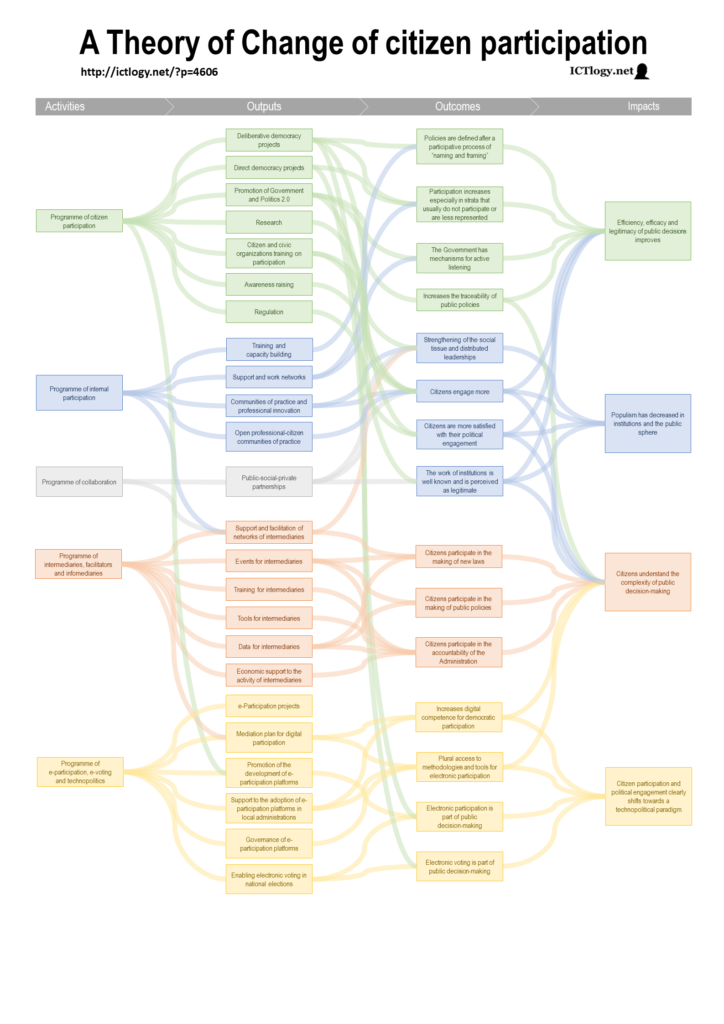This is a three-part article entitled Fostering non-formal and informal democratic participation. From mass democracy to the networks of democracy.
The first part deals with Man-mass and post-democracy and how democracy seems not to be maturing at all, or even going backwards due to lack of democratic culture and education. The second one deals with the Digital revolution and technopolitics and reflects about how the digital revolution might be an opportunity not only to recover but to update and transform democracy. This third part speaks about what kind of Infrastructures for non-formal and informal democratic participation could be put in place.
Democratic participation happens in a planned and structured way: elections, sessions in the representation chambers, etc. they have their place in time and an internal order for their development.
Non-formal participation lacks the first feature: although it has an internal structure —provided often by institutions, but increasingly by citizens without an entity behind it— it takes place ad-hoc to respond quickly to a specific issue.
Informal participation, finally, is one that is neither planned nor does it have an internal structure determined as a spontaneous manifestation or assembly, or many debates in spaces such as social networks.
The general objective of a policy to promote infrastructures for non-formal and informal democratic participation is to identify actors, facilitate spaces and provide instruments that enrich the non-formal and informal democratic practice so that it achieves its objectives, either directly or through channeling action at some point towards a democratic institution.
- Actors: in addition to people who may have an interest or knowledge in a given policy, articulate the participation and active intervention of intermediaries (prescribers, experts, representatives), facilitators (experts in making happen democratic participation actions) and infomediaries (experts in the treatment of data and information for public decision-making).
- Spaces: create the conditions so that the actors can work together, either coinciding in time and space as with other “spaces”, facilitating especially the conditions of participation, mediation strategies, channels and codes, weaving the network and explaining its operation.
- Instruments: methodologies, operating regulations, technological support (digital or analogue) for information, communication, decision-making and return.
For the deployment of this policy to promote infrastructures for non-formal and informal democratic participation we propose six axes or priority action programs:
- Deliberative participation program: to promote and improve projects on deliberative democracy, government 2.0, an appropriate regulatory framework for citizen participation, and awareness of the importance of this instrument through training, research and dissemination.
- Program of electoral participation and direct democracy: promote and/or improve electoral processes to increase the legitimacy of formal participation processes, as well as projects on direct democracy consisting of the return of sovereignty to the citizen; raise awareness about the importance of these instruments through research and dissemination.
- Internal participation program: work towards a transformation of how the Administration understands participation, collaboration and cooperation within the institutions as well as in its relationship with citizens, through training and support networks and work, communities of professional innovation practice and open communities of practice between public professionals and citizens.
- Collaboration program: with the objective of standardizing and normalizing public-social-private consortiums and innovation initiatives according to the quadruple helix model; or, to put it another way, to work for the planning and structuring of non-formal and informal initiatives of democratic participation for its scaling and replication.
- Intermediaries, facilitators and infomediaries program: to contribute to the growth and consolidation of a trained and/or professionalized sector in the field of participation, in order to achieve the highest quality of participatory practices and projects, providing the sector and citizens involved with knowledge, instruments, technological tools or resources in general.
- E-participation, electronic voting and technopolitics program: accelerate the adoption of ICT in the field of participation, thus contributing to facilitate and standardize electronic participation, electronic voting, electronic government and electronic democracy in general, at the same time transforming the paradigm behind citizen practices based mainly on passive or merely responsive actors towards a technopolitical paradigm based on active, empowered and networked actors.
We can see a graphic representation of these six programs in the Theory of Change of Citizen Participation that appears below.
In it we can see how the programs become products or political actions that, in turn, have expected results (measurable according to the established objectives and indicators) and that, according to the theory, will lead to an impact, understood as a change in social behavior —or a latent variable impossible to measure.
As we have started saying, the expected impact wants to go far beyond the improvement of efficiency, effectiveness and legitimacy of the democratic system, although this is the first desired impact, of course.
On the one hand, one should aim at fighting populism, fighting the simplification of politics and the manipulation of citizens working to improve the social fabric, information and the involvement of citizens in public issues.
This participation, moreover, is not merely quantitative but qualitative, given that we aspire to explain the complexity of the challenges of public decision-making and management with the concurrence of citizens in the design and evaluation of them.
We achieve this, besides reinforcing the traditional channels of institutional participation, by encouraging non-formal and informal participation initiatives, establishing or re-establishing broken bridges between institutions and citizens but, above all, doing it on an equal footing, sharing sovereignties … and sharing the resolution of the problems associated with the responsibility that comes with enjoying such sovereignty, both personal and collective.
If you need to cite this article in a formal way (i.e. for bibliographical purposes) I dare suggest:
Peña-López, I. (2018) “Fostering non-formal and informal democratic participation (III). Infrastructures for non-formal and informal democratic participation” In ICTlogy,
#180, September 2018. Barcelona: ICTlogy.
Retrieved month dd, yyyy from
https://ictlogy.net/review/?p=4632
Previous post: Fostering non-formal and informal democratic participation (II). Digital revolution and technopolitics
 RSS feed for comments on this post.
TrackBack URI
RSS feed for comments on this post.
TrackBack URI


